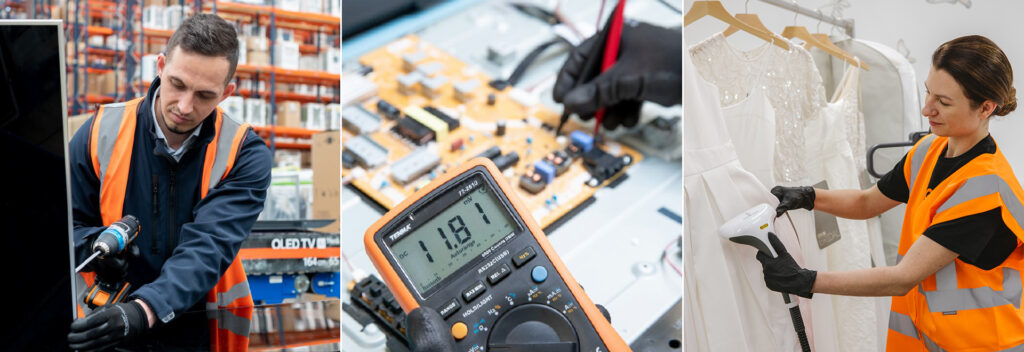
Harnessing the power of repair, refurbishment and resale processes can give your business a strategic advantage. Well-planned refurbishment and resale strategies can turn this sector of logistics into a powerhouse of cost reduction and revenue generation, helping you capture more resale value and take advantage of growing secondary markets.
Returned items lose value every day they’re not on a shelf. The global secondary market for electronic devices alone is projected to reach US$272 billion (€252 billion by 2031.1 Businesses that don’t optimize these processes are missing the potential for huge gains.
Let’s look at the factors driving the biggest results in these areas around the world.
Data-driven insights for cutting costs
Too often returns arrive at a hub only to be shipped to another facility for repair or refurbishment. Once the repairs are complete, the goods are shipped back to the original hub for distribution to a buyer on the secondary market. Seasonality adds another layer, as demand for some goods varies dramatically depending on the weather or holiday season.
Robust warehouse and returns management systems are crucial for adapting to changes in demand at scale.
- Warehouse management systems (WMS) start collecting data the moment any item arrives at your facility and can trigger pre-planned processes at the SKU level. This way you know the pathway for a particular item.
- Returns management systems (RMS), one component of a robust WMS, focus on items entering your warehouse for return. An RMS will track, store and parse data through all parts of the receiving, inspection and grade repair processes.
These dynamic SKU-based systems allow you to triage and prioritize top sellers and seasonality, rather than treat every item with the same level of urgency and simply work through a backlog.
Imagine a 48-foot trailer backs up and it’s full to the gills. How quickly can you see if something is in sellable condition? Can you repair it? Should it go straight to recycling? Do you already have the parameters pre-loaded so you know how to quickly maximize the return to the customer? We do. You want to focus on the areas that will create the most value.
WMS and RMS data also can inform product development and design: If a particular product is being returned often and for the same reason, these systems can flag that, allowing you to make changes in manufacturing to minimize future returns.

Value capture in secondary markets
Returned goods are often sold in bulk to wholesalers or recycling companies, which then either sell the items on secondary markets or dispose of them.
The traditional model looks like this: When stock comes back and it’s faulty, businesses often don’t really know what to do with it — and they can’t resell it because it’s not up to market standards. The quick and easy route is to agree to a bulk buy sold-as-seen deal with a wholesaler that can just take all the goods off their hands. But this presents a host of concerns for businesses with returned goods:
- Because wholesalers assume the risk of goods that are irreparable or in low demand, they can command low prices, which means limited value capture for businesses.
- Wholesalers may not follow sustainability best practices when discarding parts or irreparable goods, and the risk of liability could come back to you.
- In the case of electronic devices, there is no guarantee that devices’ data will be properly wiped before resale.
- General Data Protection Regulation (GDPR) data breaches are a significant risk. In Europe, the maximum fine for infringements is €20 million (about £18 million), or 4% of annual global turnover, whichever is greater.2
With specialized data eraser software, which we always use, companies can be sure items have been wiped and are protected.
Businesses can, often with the help of an expert third-party logistics partner, manage ecommerce sites and sell repaired devices, recovering as much as 80% of the best price on the web. This method, combined with optimized repair and refurbishment practices, can lead to significant boosts in revenue, and capture value in secondary markets. In many cases, these third-party partners receive a percentage of the resale price rather than a flat fee for repairing the devices. This provides an additional incentive for them to capture the highest market value — both for themselves and their clients.
Having official supplier accreditation and credentials can also help boost resale values. When goods on the secondary market are sold by an accredited service provider, buyers know the seller has an added degree of expertise, as well as access to genuine replacement parts and training from the manufacturer.
Let’s look at the growing secondary market for fashion and apparel as an example: Third-party logistics providers, or 3PLs, who specialize in clothing refurbishment may have technologies that can give life to an otherwise unsellable item. In the case of one 3PL, if a coat that someone has clearly smoked in is returned, they have a special chamber that can completely remove the scent of smoke in just 30 minutes. A coat that once would automatically go to the landfill is now viable on the secondary market.

Making the most of team resources
We believe people make a difference. “Multi-skilled” workers — those trained in multiple roles or stages of the process — allow for much more flexibility in the repair chain. A multi-skilled team can meet changes in demand much faster than a team composed solely of highly specialized workers.
This training and expertise allow teams to document specific processes for specific repairs. For example, a team could identify the 10 most common repairs for a particular item and develop decision-tree matrices for evaluating the item, diagnosing the necessary repairs and identifying what parts will be required. Thus, when that item is returned, the team can quickly and efficiently identify likely faults at the various stages and automatically determine the internal repair route the item will take. This also gives us the ability to ensure the parts are in stock and ready before we receive the faulty unit. Creating a culture of continuous improvement leads to cost savings and higher-quality repairs.
Speed and sustainability at scale
Expert 3PLs can offer fully equipped facilities, including cost-effective multi-user hubs, which allow businesses to quickly incorporate these solutions into their supply chain and see the benefits much faster. Two examples shine a light on how these solutions can benefit companies:
- Case 1: Working with a leading consumer electronics and durable goods manufacturer, we created an asset-recovery process that helped give products a second life while minimizing overall waste. Processing more than 40,000 TVs over the past three years, this manufacturer has been able to grow and upscale during peak periods. The asset recovery process has ensured that more than 75% of returned TVs are put back into the market to be re
–used. GXO has worked to decrease the amount of electrical waste while increasing the resale value of the recovered TVs by over 10%.
- Case 2: For another leading consumer electronics manufacturer, we created a purpose-built repair center to repair and refurbish TVs and staffed it with experienced technical engineers. In the first year of operation, the center processed more than 20,000 units in a range of sizes and colors, with the objective of returning 100% to market. We also established an outer packaging solution that refurbishes the original single-use plastic-free packaging for reuse. This significantly reduced the requirement for new boxes and minimized associated packaging waste.
These types of solutions give businesses access to the circular economy, which means they’ll have far fewer goods in need of scrapping. It is important to know that for those remaining items that must be discarded, an expert partner can provide access to a disposal network that can produce big savings by leveraging all available tools.
Contributing to the circular economy in this way also has secondary benefits when it comes to growing your business. Communicating these efforts to the consumer and providing them with as much value as possible can drive greater affinity for a brand, which can influence the consumer’s next purchase.
The ability to get high-value items returned, repaired and refurbished in a timely manner while taking care of your client is game-changing. If the return experience is poor, most people will reconsider their view and simply look for a suitable substitute for that product or supplier.

Unlocking profit potential
Repair and refurbishment can boost your business’s bottom line with the right technological control systems and expertise. These solutions can yield exponential results in efficiency and accuracy, and the right management systems can help businesses make data-driven decisions that could yield game-changing savings.
So why wouldn’t a company take this approach? We often hear the same three objections. First, people tend to think that what worked for another business won’t work for theirs, that the solutions aren’t one-to-one — but the differences from industry to industry are smaller than people believe. It’s really about the orchestration of how you get something out the door, how you execute what the WMS and RMS are telling you, and how you deploy the right technology in the right place. Second, they think it’s going to place too big a burden on their IT teams. However, expert 3PLs often have readily available and deployable systems via APIs that make implementation fast and easy. Third, they assume it’s too costly. We believe that’s because they simply haven’t done the numbers: The increase in revenue from secondary markets combined with cost-cutting efficiencies can far outweigh the investment.
Whatever risks businesses perceive in adopting this strategy, doing nothing is an even bigger risk. Businesses that don’t optimize their repair and refurbishment processes may be leaving money on the table — and losing customers. A 2022 survey found that 57% of shoppers are willing to abandon a brand entirely after just one poor post-purchase experience.3
The clock is ticking. Brands that want to capitalize on these trends should look for ways to turn cost centers into profit centers. Implementing data-driven solutions that capture value in secondary markets, making the most of team resources, and ultimately unlocking the profit potential of your returned goods can help you get there.
1 “Refurbished Electronics Market,” Transparency Market Research, October 2022
